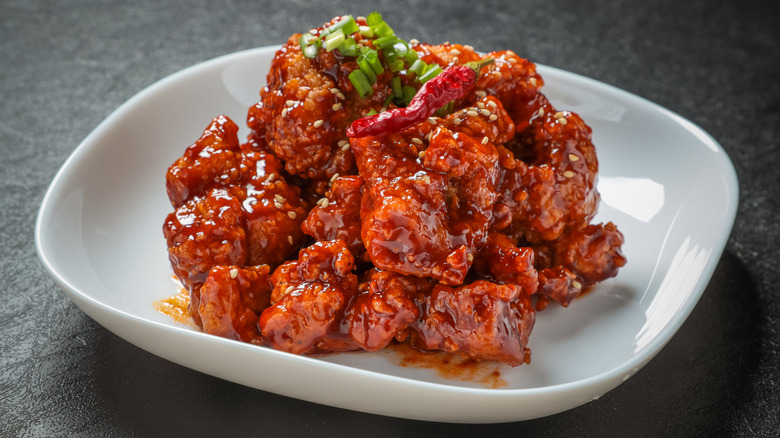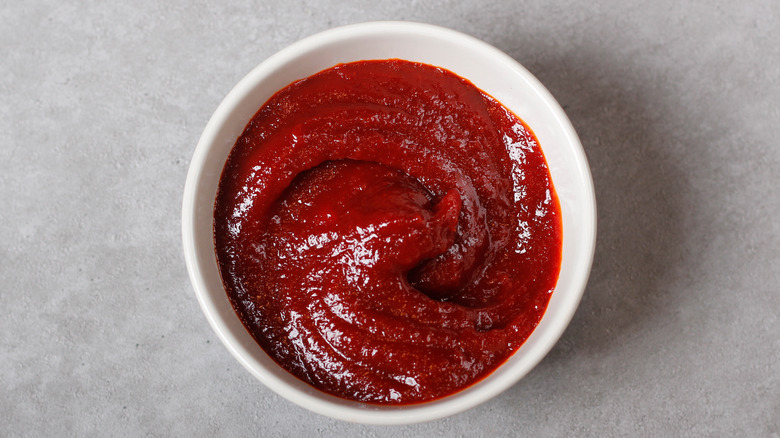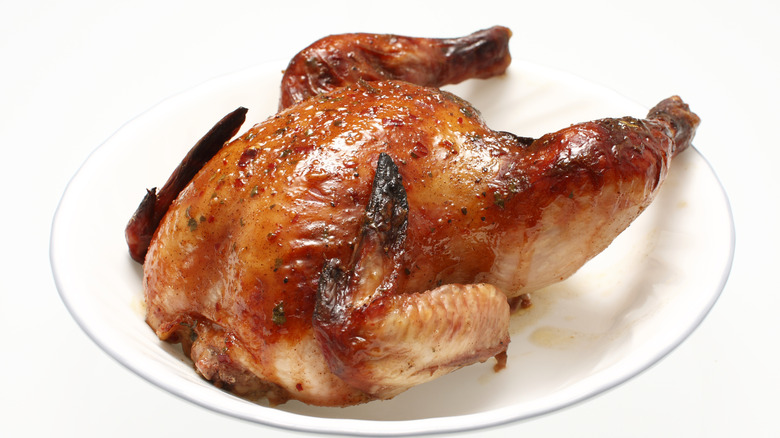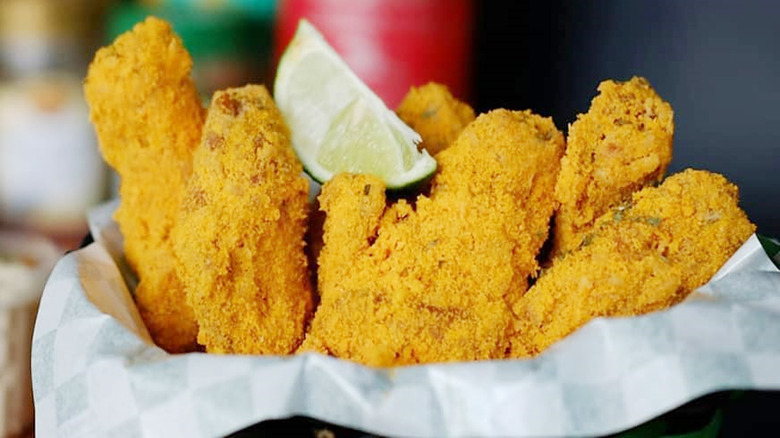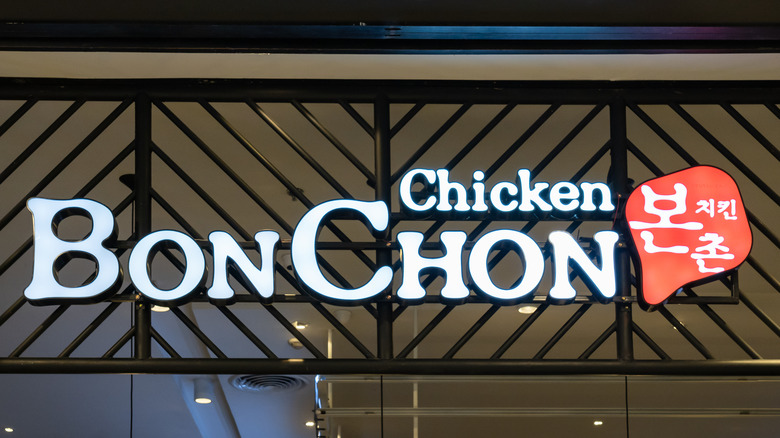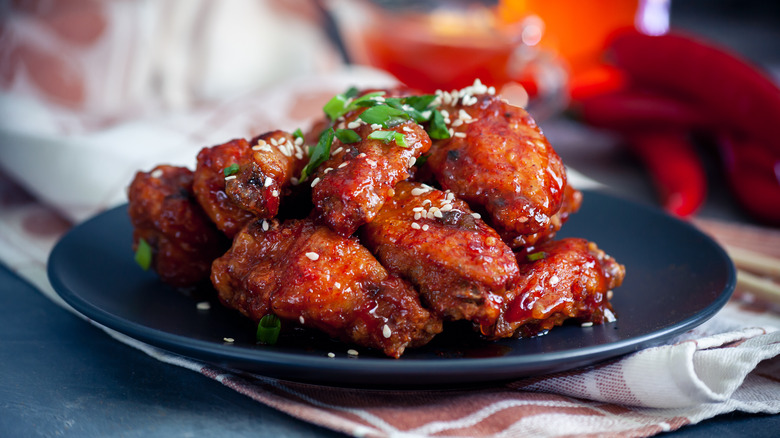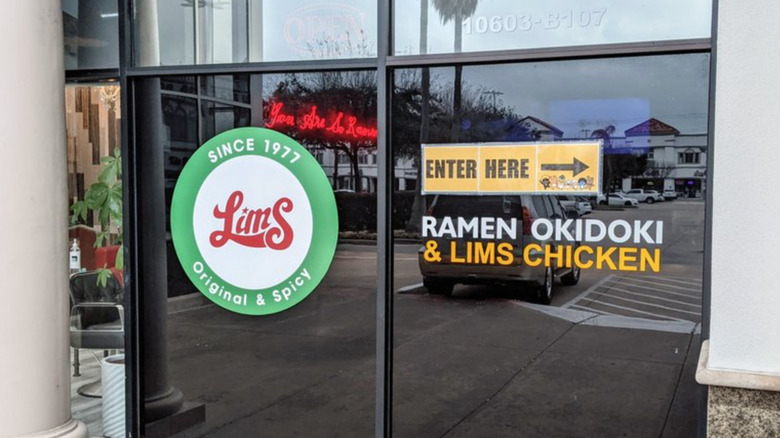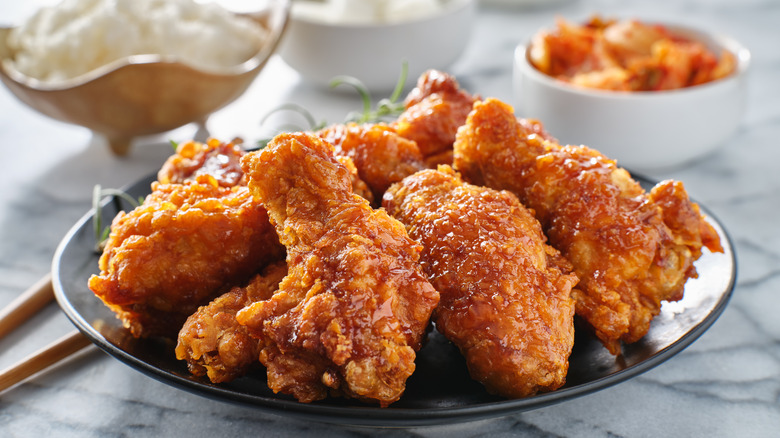The Untold Truth Of Korean Fried Chicken
Korean fried chicken. There's a good chance you've heard people around the world singing its praises. With its perfectly succulent tenderness, incredibly crispy skin, and trademark glaze that's equally sticky, sweet, and spicy, it's no wonder why Korean fried chicken is winning the world over one drumstick at a time. Irresistibly indulgent, undeniably delicious, and increasingly accessible, Korean fried chicken is taking the crown to become the undisputed king of freshly-fried fare.
Even if you're well-acquainted with the delicious magic of Korean fried chicken, you may have a few lingering questions about this dish. How did Korean fried chicken's meteoric rise begin? Is there a secret ingredient that makes it so tasty? When did the first Korean fried chicken restaurant open up? Luckily for you, we did some digging around and found the answers to these questions and more. So grab yourself a box of this famously juicy chicken that started on a distant subtropical peninsula and prepare to have your hunger and curiosity satisfied. Here is the untold truth of Korean fried chicken.
It may have originated from the Korean War
Like most stories surrounding the history of a specific food, tracing back the journey of Korean fried chicken to its precise origin is a bit challenging. While we may never get a full picture of the exact circumstances that created this dish, the general consensus seems to be that Korean fried chicken was dreamed up at some point during the Korean War. According to Smithsonian Magazine, some scholars believe that the presence of the US military in Korea during the war played a role in the dish's development.
This theory makes sense, considering that other famous dishes rose from the ashes of the Korean War. Budae jjigae, for example, is a popular Korean soup that translates to "army stew" due to its use of ingredients introduced by the US military. One look at a recipe illustrates an unlikely fusion: Spam and sliced-up hot dogs simmer in a pot with chili paste, kimchi, garlic, and noodles that's often topped with a slice of American cheese. In the decades following the war, Western-style chicken restaurants started popping up around the country, setting the stage to spark a craze for Korean fried chicken.
The Asian financial crisis expanded the market
You wouldn't think that a financial crisis would trigger an explosion of new small businesses, but according to Foreign Policy, that's exactly what happened in South Korea during the late 90's. After the Korean War, South Korea experienced unprecedented economic growth for decades. To put some of this rapid growth into perspective, consider that South Korea went from being a relatively undeveloped agriculture-based economy during the 1960's to an advanced technological powerhouse with the 11th largest economy in the world by 2016 (via Federal Reserve Bank of St. Louis).
This period of accelerated growth fueled a spread of good jobs in South Korea that offered generous pensions, college tuition, and housing assistance that built a strong middle class. Unfortunately, a mixture of poorly-managed finance policies and crony capitalism shattered this period of collective prosperity and set off an economic downward spiral known as the Asian financial crisis (via Center for Independent Studies). The aftermath of the financial crisis left many Koreans jobless and without any economic security, but some of them received a severance payment.
Unemployed and unsure of what to do, many Koreans decided to use their severance payment to reinvent themselves by opening up family-run restaurants, including fried chicken joints. Low interest rates following the crisis also made it easier to take out loans that could be used to kick-start new businesses. As a result, South Korea's restaurant scene became extremely dynamic and competitive, making fried chicken even more popular.
Ketchup is the unsung hero
Ketchup kinda gets a bad rap. What started out as one of the first condiments we ever ate seems to become less socially acceptable to enjoy with age, disapprovingly tethered to the simplistic diet of childhood with snooty accusations of having an unrefined palate. We'd like to clear the air and let all of you ketchup lovers out there know that we see you, we love you, and we're with you. There's no shame in using any condiment however you like to. That said, you might be surprised to learn that ketchup is one of the star ingredients in Korean fried chicken's legendary glaze, yangnyeom sauce, according to Korean cooking icon Maangchi.
While Korean fried chicken is available in a variety of different flavors, yangnyeom sauce is the bright red glaze you most often see advertised on menus and pictures. Made with a blend of ketchup, gochujang (fermented chili pepper paste), minced garlic, white vinegar, and rice syrup, this sauce has a complex flavor profile that's sticky, sweet, and spicy. There's no doubt that part of Korean fried chicken's mass appeal is due to this famously tasty sauce, which perfectly clings to the fried chicken's crispy batter.
There's a secret to Korea's tender meat
Plenty of cooks have secrets that take their dishes to the next level. Having a few tricks up your sleeve in the kitchen can really elevate the food, whether it's exclusive access to special ingredients or using a mastered technique. And if you've ever eaten Korean fried chicken in South Korea, you know that the chicken (even the cuts of white meat) taste extra tender for some reason – but you may not know why.
The secret has less to do with proficiency or a secret recipe and more to do with the actual chicken itself. Korea's chickens are actually much smaller than the birds we eat in America (via New York Times). And according to chef J. Kenji Lopez-Alt, the smaller birds in South Korea end up tasting more tender because their miniature bodies actually have a more consolidated cluster of connective tissue (via Serious Eats). So while it's true that Korean fried chicken tastes great partly because of its unique sauces, it's also true that it has something to do with the physical makeup of the Korean chickens themselves. This concentration of connective tissue is the same reason that Cornish game hens (which, despite the fancy name, are really just small chickens) are more tender.
It's often coated with a cheese powder
It's fairly common to garnish fried chicken with different ingredients for extra flavor and texture. Chopped nuts, thin slices of green onions, and a scattering of sesame seeds are just a few of the toppings you might see coating a freshly-fried batch of Korean fried chicken. But there's another common topping that is less of a garnish and more of an extra coating that covers the entire surface of the chicken: Cheese powder (via Honolulu Magazine).
That may sound a bit strange at first, but stay with us. The flavors of fried chicken and cheese go together hand-in-hand. How often have you dunked a crispy drumstick into some blue cheese? Or ordered a plate of parmesan garlic buffalo wings? The main difference here is that the cheese powder is more yellow in color and the flavor mimics the sharp notes of cheddar in macaroni and cheese more than parmesan. There are other powdered flavors too, like honey butter seasoning, which adds a luscious layer of sweetness and richness to the chicken. The bottom line is this: If you dig fried chicken and you love the taste of cheese, trying out some Korean fried chicken tossed in a little sauce and some cheese powder is a surefire way to light up your tastebuds.
There's a special word for Korean fried chicken and beer
You can learn a lot about what's important to a culture by its language and unique vocabulary. The glorious mix of hot fried chicken and cold beer is so beloved in Korea that there's a special word in the Korean language to describe their harmonious combination. The word "chimaek" joins together the word chicken with the Korean word "maekju" which translates to beer (via CNN).
In South Korean drinking culture, it's very important to keep eating while you consume alcohol (via Maangchi). And while chimaek is one of the best examples of this, there's a wide range of drinking snacks – called "anju" – to choose from in Korea. Some popular anju dishes include grilled pork belly, kimchi stews, mung bean pancakes, spicy pork, and braised octopus. As it turns out, the Korean tradition of continuing to eat during longer drinking sessions is a pretty good idea. According to Insider, consuming food can stop you from getting too drunk by slowing down alcohol absorption. And eating some fried chicken or fresh slabs of crispy pork belly sounds like the best possible way to do that.
It works great in sliders and tacos
Everything evolves over time and that includes our food culture. While Korean fried chicken started out being served up in its traditional form in boxes and buckets, some restaurants are now experimenting with fusion applications of this dish to great acclaim. That's the beauty of chicken – it's one of those meats with mass appeal that can seamlessly blend into new dishes in inventive ways.
Bonchon Chicken is a Korean fried chicken restaurant with locations all over the United States that's pushing the boundaries of this dish. By creating a menu with items that fuse the tradition of Korean fried chicken with the handheld sandwiches of the West, Bonchon is devising new interpretations of Korean fried chicken that make it more accessible. One of the standouts from the Bonchon menu includes Korean fried chicken sliders with coleslaw, cucumbers, red onions, and spicy mayo. Another is the Korean taco plate, which comes with the same ingredients but adds some buttermilk ranch and wraps it all up in flour tortillas. The soy garlic and spicy sauces allow you to customize the flavor profile of these dishes in a way that compliments the rest of the ingredients. If you dig fried chicken sandwiches and tacos, then don't miss out on these dishes from Bonchon.
A surprise ingredient makes it extra crispy
No one likes soggy fried chicken. A big part of the allure of fried chicken is biting into its perfectly seasoned, crispy exterior with its battered crags of crunchiness. While achieving a sufficient level of crunch can be accomplished in a variety of different ways, some methods work better than others. One of the most effective ingredients just might be one that you've never tried before.
According to Life Hacker, the secret ingredient in the best Korean fried chicken batter is vodka, which only requires two tablespoons for every cup of marinade. Because vodka is more inherently volatile than other brines, it swiftly and fiercely evaporates on the surface of the chicken skin when submerged in hot oil, creating more bubbles that harden on the exterior to create more texture. We're willing to bet that using a splash or two of soju – the most popular spirit in the world (that's often referred to as "Korean vodka") – will also do the trick. Once again, it seems that alcohol and fried chicken are pretty much the perfect pairing.
It's the most popular Korean dish among foreigners
Considering Korean fried chicken's deliciousness, it should come as no surprise that foreigners agree it's one of the best-tasting dishes the country has to offer. According to The Korea Herald, Korea's Ministry of Agriculture, Food, and Rural Affairs conducted an online survey of more than 8,000 residents in 16 cities around the world. The survey found that most respondents chose Korean fried chicken as their most-preferred Korean dish. Following closely behind Korean fried chicken was kimchi in second place, and bibimbap in third place.
Over 80 percent of the foreigners surveyed reported that they were satisfied with the overall flavor profile of Korean food. The results also showed that North America prefers Korea's beef dishes to its pork dishes. Perhaps more interestingly, Tokyo and Rome reported the lowest level of satisfaction with Korean food. We could speculate about the reasons for these results, but the bottom line is that out of all the dishes that Korea has to offer, Korean fried chicken seems to resonate with foreigners the most. While it's true that plenty of other countries cook up versions of deep-fried chicken, there's no doubt that the Korean-style has its own charms with unique sauces, exceptionally tender meat, and tasty toppings.
Tikkudak is a new twist on Korean fried chicken
Remember how we said that food is always evolving? Well, it appears there's already a new twist on Korean fried chicken that's bound to make your mouth water. What makes this new interpretation different from traditional Korean fried chicken? There's an extra step to the cooking process that adds a whole new layer of flavor.
According to The Washington Post, this new Korean fried chicken dish is called "tikkudak". Tikkudak seems to be a linguistic mashup that combines Korean words that mean fried and grilled with "dak", a Korean word that translates to chicken. Tikkudak can refer to wings, tenders, or a whole chicken that gets double-fried and then baked in a charcoal oven in order to get extra crispy and achieve some assertive notes of smoke. There is no liquid smoke or artificial flavoring involved. Instead, the wings are sauced fresh out of the fryer and then baked with charcoal for a couple of minutes. We're drooling already.
As if fried chicken wasn't delicious enough, this new variation elevates the dish to stratospheric levels of heavenly flavor. Whoever came up with the idea to smoke freshly-fried Korean chicken in a charcoal oven for some extra smokiness deserves an award for culinary greatness. We tip our hats to this new dish and hope to see it on a menu soon.
Lims Chicken opened a location in the US
We all know that Korean fried chicken is amazingly delicious. But what was the first Korean fried chicken franchise? And how long has it been in business?
According to Houstonia, the first Korean fried chicken franchise was Lims Chicken, which opened in the basement of a department store in Seoul back in 1977. The restaurant proved so successful that it became the country's first fried chicken franchise. For decades, the chain stayed within the confines of its native homeland, but finally decided to branch out into the American market by opening a location in Houston in 2016.
The fried chicken batter at Lims is apparently more similar to tempura than it is to the heavier coatings you might see at other fried chicken joints, which could be a good thing depending on your preferences. The portions are generous and there's also plenty of different dipping sauces to choose from, including sweet, gochujang, spicy, and honey mustard. While the menu offers Korean fried chicken, it also offers more traditional Korean dishes too, so if you're in the mood for a stew or some Korean barbecue, Lims has you covered.
The Korean fried chicken craze is growing
Now that the world is catching on Korean fried chicken, the race to dominate the market is underway. According to Fast Casual, Mom's Touch – a fried chicken franchise based in South Korea – opened up its first location in the US in Los Angeles County in 2021 and soon followed up with another location in Long Beach. There are currently plans underway to expand the chain further across the country.
Another Korean fried chicken franchise, Bonchon, is also planning for expansion across the United States (via Insider). With over 100 locations already in the US, it seems that Bonchon may be poised to rise to the top of this increasingly competitive market. Between the new twists of Korean fried chicken being created and new restaurants opening up in the US, it's pretty clear that we're only at the beginning stage of the Korean fried chicken craze that's crawling around the globe. And we're totally on board with it.
